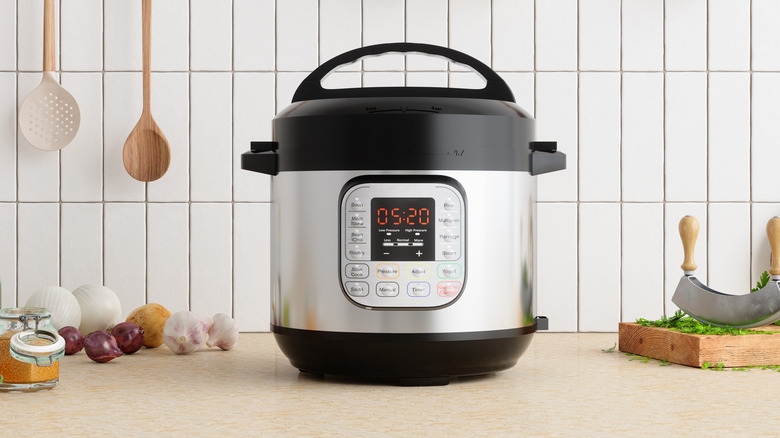The Foolproof Way To Poach Eggs In An Instant Pot
One of the incredible things about the egg is the many forms in which it can be prepared. You'll find eggs at a local diner just as easily as a fine-dining restaurant. And fortunately, they're one of those ingredients that are completely approachable at home, at any time of day, regardless of skill level.
And yet, while many feel comfortable taking a stab at scrambling, frying, boiling or even crafting the perfect omelet, one preparation does seem especially intimidating to home cooks, and that's poaching. It turns out though, that if you can get your hands on a few tools, you can perfect your poaching technique at home. And that is a critical skill if you want to satisfy a classic eggs benedict craving anytime.
If you've seen the slow cooker hack for poached eggs, this tip might be familiar, but in this case all you need is your trusty Instant Pot and a vessel like a silicone cup, or oven-safe glass jar or bowl. Armed with only these items, in less than ten minutes, you can confidently have the poached egg of your avocado toast's dreams.
The instant pot poach approach
There are competing theories and so-called secrets about how best to poach an egg, but with your Instant Pot, you narrow down your variables. First, select your vessel: Silicone egg mold (easily found online or in a kitchen store), or glass bowl or jar (just be sure it's oven-safe). Butter, cooking spray, and ghee will all work well for greasing, but be generous as a stuck poached egg will be hard to rescue.
Your last major decision is about cook time. Do you prefer a runny egg? About three minutes will get the job done. If you'd rather a firmer, jammier yolk, you'll want to hold out for a few more — about five or six minutes in total. Using the quick release setting can be a good call for foods that are made this quickly, as it will help halt any further cooking. When poaching an egg those extra moments make a difference.
Instant Pots vary in power and settings, and some users recommend a low level while others suggest high, so it may take a bit of trial and error to get the perfect formula for your eggs and appliance. The vessel may impact results, too, as glass conducts heat and silicone does not. The beauty of this method though, is that once you've dialed in your process, it's a snap to replicate whenever the mood for poached eggs strikes.
More egg poaching tips
When poaching eggs it's always best to set forth with the freshest possible. The older the egg, the more likely the yolk is to break during the cooking process, no matter the method. Also keep in mind that for consistent results, it's recommended to use room temperature eggs.
You can even make your poached eggs ahead of time, and store them in an airtight container in the fridge. They'll keep for up to two days, and you can warm them back up easily. Boil enough water to submerge the egg on the stove, then turn off the heat (as an aggressive, agitating boil can rupture your yolk). Gently slide your egg into the hot water using a slotted spoon or similar until it's nice and warm again — just don't leave it too long (less than a minute should do) or you'll wind up cooking it further.
Next recipe to perfect? Perhaps making a homemade English muffin that's a worthy stage for your poached eggs. Once you've mastered the foolproof Instant Pot poach, you'll feel prepared for anything.


